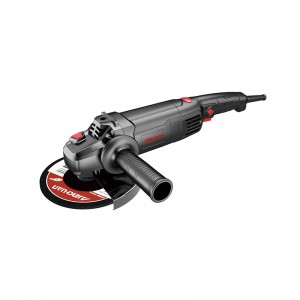In the industrial and DIY fields, the Angle grinder is one of the indispensable tools. However, prolonged use of an Angle grinder may cause hand fatigue and discomfort. To alleviate this fatigue, the application of ergonomic design in Angle grinders becomes particularly important. This article will explore five key elements in the ergonomic design of light Angle grinders. These designs can significantly reduce the fatigue of users and enhance the user experience.
First, lightweight design
Lightweighting is one of the key designs for reducing operator fatigue. By adopting high-strength lightweight materials, such as aerospace-grade aluminum alloys and high-performance polymers, the light Angle grinder can effectively reduce the overall weight. This not only reduces the load on the arms and wrists during long-term operation, but also enhances the flexibility and operational endurance of the workers, ensuring high efficiency and stability during continuous operation.
Second, ergonomic handle design
The handle is the part of the Angle grinder that comes into contact with the operator most frequently, and its design directly affects the comfort and fatigue level of the operation. The handle of a light Angle grinder is usually wrapped with soft materials that conform to the contour of the human hand. This not only provides a good grip but also guides users to hold it in the correct posture through a reasonable shape design. In addition, the tilt Angle and length of the handle will also be adjusted according to different working scenarios, making the operation more in line with ergonomic principles and further enhancing the comfort and flexibility of use.
Third, vibration suppression technology
When using an Angle grinder for a long time, vibration is an important factor leading to hand fatigue and injury. To reduce the impact of vibration on the operator, the light Angle grinder adopts advanced vibration suppression technology. These technologies are applied in motors and drive systems, which can significantly reduce the vibration level transmitted to users’ hands and effectively prevent the occurrence of vibration diseases. By reducing vibration, the light Angle grinder not only enhances operational efficiency but also ensures the occupational health and safety of users from the source.
Fourth, reasonable weight distribution
The light-duty Angle grinder was designed with full consideration of the rationality of weight distribution. Through scientific calculation and experimental verification, the overall weight of the tool is reasonably distributed to ensure a stable center of gravity and easy control. This design reduces the additional burden caused by uneven weight, enabling the operator to control the tool more easily during long-term use and further alleviating the fatigue of the hands and arms.
Fifth, intelligent auxiliary design
With the continuous advancement of technology, intelligent auxiliary design has been widely applied in Angle grinders. For instance, by monitoring the usage status through intelligent sensors and automatically adjusting the power, the operational difficulty and labor intensity have been reduced. This intelligent design not only enhances the user experience but also makes the use of the tool more convenient and efficient.
The lightweight Angle grinder significantly reduces the operator’s fatigue and enhances the user experience through five key elements: lightweight design, ergonomic handle design, vibration suppression technology, reasonable weight distribution, and intelligent auxiliary design. These designs not only enhance operational efficiency but also ensure users’ occupational health and safety in multiple aspects. When choosing an Angle grinder, considering these ergonomic design elements can help you select a more comfortable, efficient and safe tool.
Post time: Apr-22-2025

